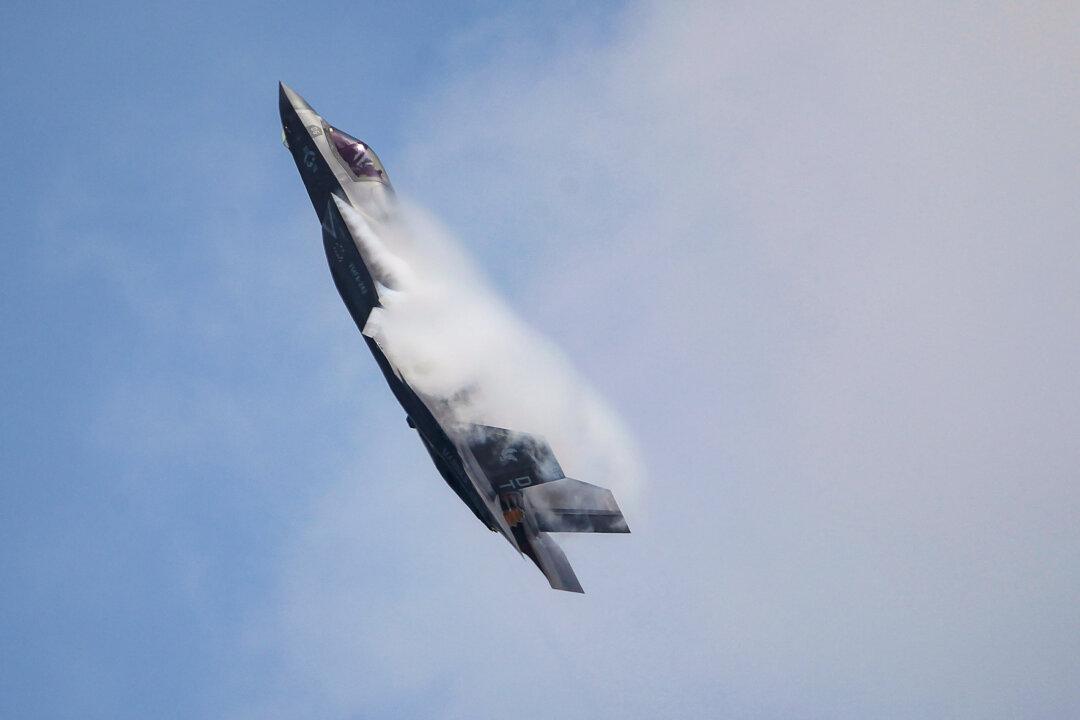Questions regarding who controls the U.S. Air Force’s F-35 fighter jet program arose in recent House Armed Services Committee budget hearings.
The F-35 Lightning II aircraft program is described by the Government Accountability Office (GAO) as the Department of Defense’s “most ambitious and costly weapon system and its most advanced fighter aircraft.”
During a hearing Wednesday, Rep. Matt Gaetz (R-Fla.) asked about concerns related to who is in control of the program as well as why the number of planes rated as “fully mission capable” is well below expectations.
“The F-35 is our signature Air Force platform,” Mr. Gaetz said. “What percentage of them are fully mission capable today?”
The response from Secretary of the Air Force Frank Kendall III was that 55 percent of the planes were operationally available.
Mr. Gaetz asked whether Mr. Kendall thought that was good or bad, to which he replied it was “not a good number,” though he didn’t agree with Mr. Gaetz that it was a “failing” number.
The testimony was in contrast to testimony presented to the Armed Service Committee’s aviation subcommittee in March 2023, when Air Force Lt. Gen. Michael Schmidt, the F-35 program manager, said that the so-called “fully mission capable” rate as of February 2023 was 29 percent.
Semantics Debated, but Numbers Still Concerning
Mr. Gaetz brought up the testimony from roughly a year ago, saying that it was “contrary” to the figure Mr. Kendall reported this week.Air Force Chief of Staff Gen. David Allvin said it was important to note the difference between “operational availability” and being “mission capable.”
Mr. Gaetz asked Gen. Allvin how many were “fully mission capable” as of Wednesday.
“I do not have that number, but I would not dispute what [Mr. Schmidt said],” Gen. Allvin replied.
“So fully mission capable—29 percent. You have no basis to dispute that but you don’t really know if it’s true or false.”
Mr. Gaetz inquired that if 55 percent was not a failing grade and instead a “D,” then 29 percent would certainly be “failing.”
“For fully mission capable, but the missions that they can accomplish—” Gen. Allvin said before being interrupted by Mr. Gaetz.
Fox Watching Henhouse
The congressman then cited a GAO report, released earlier in the week, which noted the F-35 program faced issues due to the maintenance of the vehicles being controlled by the prime contractor for the aircraft, Lockheed Martin.“Do you believe Lockheed Martin has been given too much power on the sustainment of the F-35?” Mr. Gaetz asked.
“I believe that Lockheed Martin has more power than in some other weapons systems,” Gen. Allvin said. “They do have the contracted logistics system that was part of the procurement plan that was put in place 20 some years ago.”
The GAO report noted that the F-35 program is managed as a joint multinational program, with participants such as the Air Force, Navy, Marine Corps, seven international partners, and multiple foreign military sales customers.
The Office of the Under Secretary of Defense oversees the entire F-35 program while the F-35 Joint Program Office (JPO) “manages and oversees the support functions required to field and maintain the readiness and operational capability of the F-35 aircraft across the enterprise.”
“Lockheed Martin, the prime contractor for the aircraft, manages the heavy maintenance of the aircraft (i.e., the air vehicle) and conducts the work primarily under annual contracts,” the report found.
Another contractor, Pratt & Whitney, maintains the engines which they designed and built.
“It’s not working,” Mr. Gaetz said of these agreements. “If Lockheed Martin built the F-35 and only 29 percent of them are fully operationally capable right now—we’ve all agreed that’s failing. So now the question is, why is it failing? And this GAO report says the reason it’s failing is because the fox is watching the henhouse, because the very contractor bilking the taxpayer for this platform is now in a position where they can’t sustain it. Do you have a basis to disagree with that conclusion?”
Mr. Kendall reentered the conversation, noting that he inherited the F-35 program in 2010 when it was a few years into production. He said he had asked then whether Lockheed Martin or the federal government was running the program.
“I think you have your answer, Mr. Secretary,” Mr. Gaetz added.
Mr. Kendall further explained that the program was set up under a “philosophy of management called total system performance, which essentially gave to the prime contractor complete control of the program. We did not acquire the intellectual property to allow the government to come in and step in and control the program,” Mr. Kendall added. “We are still fighting that problem today.”
“That is such important testimony for us to hear,” Mr. Gaetz said. “Every member of the committee heard that. The government isn’t running this program, Lockheed Martin’s running this program.”
Mr. Kendall added that he and others had taken “a lot of steps to try to get that under control” including imposing a “production contract on Lockheed.”
“I dictated a price to them because we couldn’t get a negotiation done,” Mr. Kendall explained. “I did a unilateral contract, let them take me to court if they wanted to, and they chose not to. We put in place program managers who were very firm with the contractor and insisted on performance. We’ve had some conversations with the current head of the JPO and we’ve had conversations with the CEO of Lockheed.”
GAO Recommendations
The GAO report further scrutinized escalating sustainment costs and persistent performance challenges with the F-35 program.GAO found that the Department of Defense (DOD) plans to procure approximately 2,500 F-35 aircraft by the mid-2040s, but projected sustainment costs have surged by 44 percent from about $1.1 trillion in 2018 to approximately $1.58 trillion in 2023.
This increase stemmed from an extension of the aircraft’s service life and other adjustments, including inflation and modifications to flight hour estimates. The cost estimate changes reflect deeper issues related to the aircraft’s extensive maintenance needs and lower than expected availability rates, according to the report.
None of the F-35 variants have met their mission-capable targets, the report further found.
Despite various cost-saving initiatives, including efforts to enhance component reliability and optimize engine maintenance, DOD officials acknowledge that these measures are unlikely to significantly reduce the program’s long-term expenses.
The GAO report underscores the limited impact of current strategies on controlling costs, stating, “DOD officials generally agree that these efforts are not likely to fundamentally change the estimated costs to operate the aircraft.”
Moreover, the GAO has identified several systemic issues, such as spare parts shortages and inadequate training systems, which exacerbate readiness challenges.
While recommendations have been made to address these shortcomings, approximately 70 percent remain unimplemented, suggesting a gap between policy and practice.







